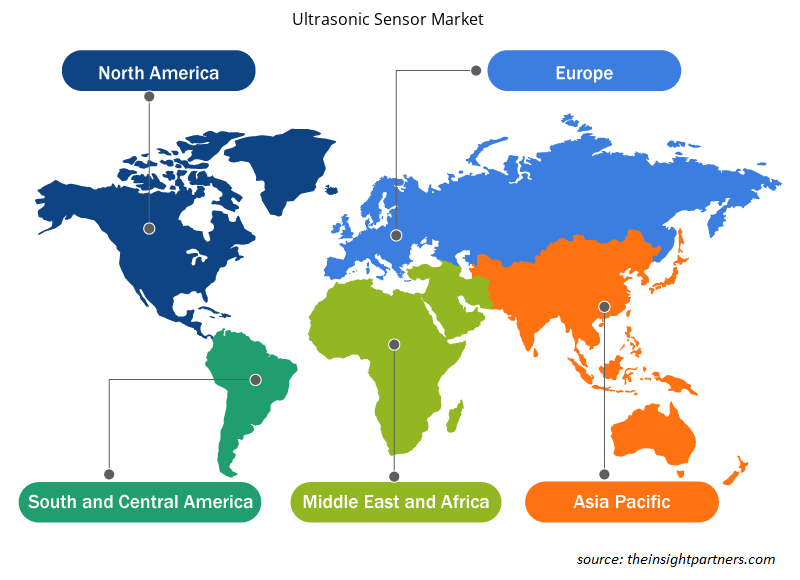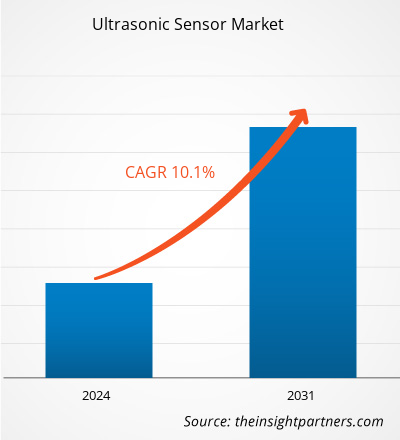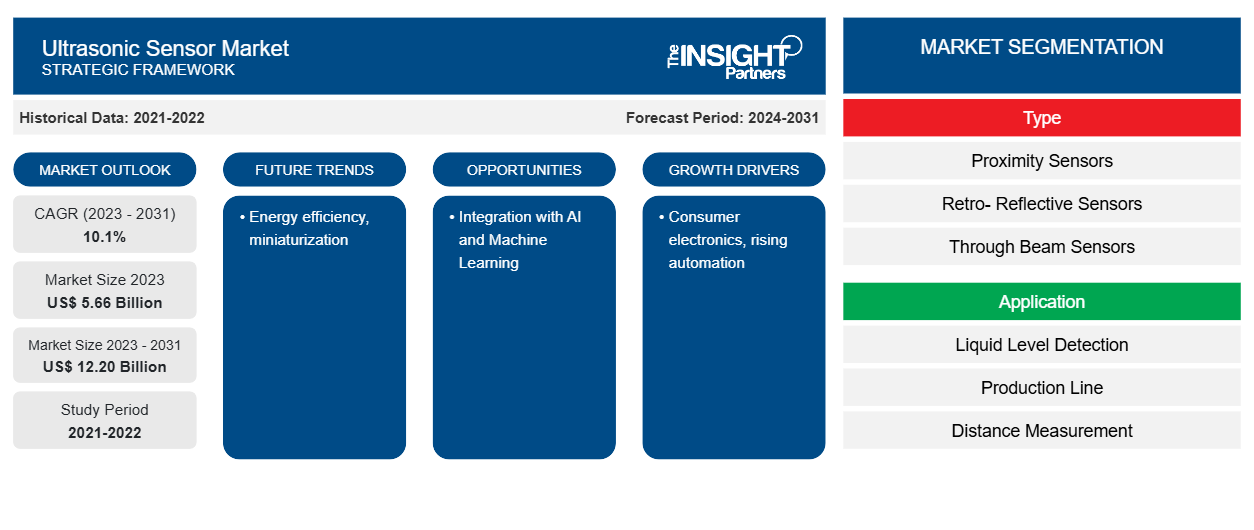Der Markt für Ultraschallsensoren soll von 5,66 Milliarden US-Dollar im Jahr 2023 auf 12,20 Milliarden US-Dollar im Jahr 2031 anwachsen. Der Markt soll zwischen 2023 und 2031 eine durchschnittliche jährliche Wachstumsrate (CAGR) von 10,1 % verzeichnen. Energieeffizienz und Miniaturisierung dürften weiterhin die wichtigsten Trends auf dem Markt für Ultraschallsensoren bleiben.
Ultraschallsensor-Marktanalyse
Ultraschallsensoren werden weltweit für eine Reihe von Anwendungen eingesetzt, sowohl im Innen- als auch im Außenbereich, unter schwierigen Bedingungen. Ultraschallsensoren können im Herstellungsprozess verwendet werden, um die Prozesssteuerung in der Fabrikhalle zu automatisieren, und sie sind auch ein wichtiges Werkzeug für Unternehmen, um die Produktivität durch präzise Messung und Steuerung zu maximieren. Ultraschallsensoren können die Entfernung zu einer Vielzahl von Objekten schätzen, unabhängig von Form, Farbe oder Oberflächenbeschaffenheit. Sie können auch ein Objekt messen, wenn es sich nähert oder entfernt. Für ähnliche Anwendungen werden Ultraschallsensoren unter anderem in wichtigen Branchen wie der Automobilindustrie, der Fertigung und dem Gesundheitswesen eingesetzt . Dies treibt das Marktwachstum voran.
Marktübersicht für Ultraschallsensoren
Die aktuelle Industrielandschaft mit massiver IoT-Integration und industrieller Automatisierung hat einen beeindruckenden Raum für die Ausweitung der Anwendungen für den Einsatz von Ultraschallsensoren geschaffen. Die steigende Automatisierungskomplexität im industriellen Umfeld führt die Nachfrage auf dem Markt an. Die Marktteilnehmer sind aktiv an der Einführung neuer und innovativer Produkte beteiligt. So stellte Toposens im August 2022 den weltweit ersten 3D-Ultraschall-Kollisionsvermeidungssensor für den Einsatz in industriellen Anwendungen vor, um die Produktivität und Sicherheit durch den Einsatz automatisierter Geräte zu verbessern.
Passen Sie diesen Bericht Ihren Anforderungen an
Sie erhalten kostenlose Anpassungen an jedem Bericht, einschließlich Teilen dieses Berichts oder einer Analyse auf Länderebene, eines Excel-Datenpakets sowie tolle Angebote und Rabatte für Start-ups und Universitäten.
-
Holen Sie sich die wichtigsten Markttrends aus diesem Bericht.Dieses KOSTENLOSE Beispiel umfasst eine Datenanalyse von Markttrends bis hin zu Schätzungen und Prognosen.
Treiber und Chancen auf dem Ultraschallsensormarkt
Steigende industrielle Automatisierung begünstigt den Markt
Ultraschallsensoren sind vielseitig einsetzbare Sensoren im Bereich der industriellen Automatisierung. Es sind mehrere Varianten erhältlich, die jeweils auf eine bestimmte Anwendung zugeschnitten sind. Ultraschallsensoren in automatisierten Produktionslinien sorgen dafür, dass Roboterarme und Maschinen ordnungsgemäß funktionieren. Sie unterstützen bei Aufgaben wie der Ausrichtung von Komponenten und stellen sicher, dass Teile für die Montage oder Verarbeitung richtig positioniert sind.
Integration mit KI und maschinellem Lernen – eine Chance für Ultraschallsensoren
Ultraschallsensoren werden zunehmend mit künstlicher Intelligenz (KI) und Algorithmen für maschinelles Lernen integriert. Diese Integration ermöglicht eine intelligentere Datenverarbeitung, sodass Sensoren auf sich ändernde Bedingungen reagieren und genauere Vorhersagen treffen können. Diese Verbesserung ist vielversprechend für komplizierte Anwendungen wie vorausschauende Wartung und Qualitätskontrolle.
Ultraschallsensor-Marktbericht – Segmentierungsanalyse
Wichtige Segmente, die zur Ableitung der Marktanalyse für Ultraschallsensoren beigetragen haben, sind Typ, Anwendung und Branche.
- Basierend auf dem Typ ist der Markt für Ultraschallsensoren in Näherungssensoren, retroreflektierende Sensoren, Einweglichtschranken und andere unterteilt. Das Segment der Einweglichtschranken hatte im Jahr 2023 den größten Marktanteil.
- Basierend auf der Anwendung ist der Markt für Ultraschallsensoren in Flüssigkeitsstandserkennung, Produktionslinie, Entfernungsmessung und Andere unterteilt.
- Basierend auf der Branchenverteilung ist der Markt in die Branchen Automobil, Lebensmittel und Getränke, Medizin, Öl und Gas, Industrie und Sonstige segmentiert.
Ultraschallsensor Marktanteilsanalyse nach Geografie
Der geografische Umfang des Marktberichts für Ultraschallsensoren ist hauptsächlich in fünf Regionen unterteilt: Nordamerika, Asien-Pazifik, Europa, Naher Osten und Afrika sowie Südamerika/Süd- und Mittelamerika.
Europa dominierte dieMarkt für Ultraschallsensoren. Die zunehmende Automatisierung und Industrie 4.0 in europäischen Ländern treiben die Nachfrage nach Ultraschallsensoren in der Region an. Der Markt für Ultraschallsensoren erlebt in Nordamerika eine erhebliche Entwicklung, die auf die Entwicklung der Automobil- und Transportbranche zurückzuführen ist.
Regionale Einblicke in den Ultraschallsensormarkt
Die regionalen Trends und Faktoren, die den Ultraschallsensormarkt während des Prognosezeitraums beeinflussen, wurden von den Analysten von Insight Partners ausführlich erläutert. In diesem Abschnitt werden auch die Marktsegmente und die Geografie des Ultraschallsensormarkts in Nordamerika, Europa, im asiatisch-pazifischen Raum, im Nahen Osten und Afrika sowie in Süd- und Mittelamerika erörtert.

- Holen Sie sich die regionalspezifischen Daten für den Ultraschallsensormarkt
Umfang des Marktberichts für Ultraschallsensoren
| Berichtsattribut | Details |
|---|---|
| Marktgröße im Jahr 2023 | 5,66 Milliarden US-Dollar |
| Marktgröße bis 2031 | 12,20 Milliarden US-Dollar |
| Globale CAGR (2023 - 2031) | 10,1 % |
| Historische Daten | 2021-2022 |
| Prognosezeitraum | 2024–2031 |
| Abgedeckte Segmente |
Nach Typ
|
| Abgedeckte Regionen und Länder |
Nordamerika
|
| Marktführer und wichtige Unternehmensprofile |
|
Marktteilnehmerdichte für Ultraschallsensoren: Auswirkungen auf die Geschäftsdynamik verstehen
Der Markt für Ultraschallsensoren wächst rasant, angetrieben durch die steigende Nachfrage der Endnutzer aufgrund von Faktoren wie sich entwickelnden Verbraucherpräferenzen, technologischen Fortschritten und einem größeren Bewusstsein für die Vorteile des Produkts. Mit steigender Nachfrage erweitern Unternehmen ihr Angebot, entwickeln Innovationen, um die Bedürfnisse der Verbraucher zu erfüllen, und nutzen neue Trends, was das Marktwachstum weiter ankurbelt.
Die Marktteilnehmerdichte bezieht sich auf die Verteilung der Firmen oder Unternehmen, die in einem bestimmten Markt oder einer bestimmten Branche tätig sind. Sie gibt an, wie viele Wettbewerber (Marktteilnehmer) in einem bestimmten Marktraum im Verhältnis zu seiner Größe oder seinem gesamten Marktwert präsent sind.
Die wichtigsten auf dem Markt für Ultraschallsensoren tätigen Unternehmen sind:
- Toposen
- Baumer
- Rockwell Automation
- Siemens
- Honeywell International Inc
- Pepperl+Fuchs Pvt. Ltd.
Haftungsausschluss : Die oben aufgeführten Unternehmen sind nicht in einer bestimmten Reihenfolge aufgeführt.

- Überblick über die wichtigsten Akteure auf dem Ultraschallsensormarkt
Neuigkeiten und aktuelle Entwicklungen zum Ultraschallsensormarkt
Der Markt für Ultraschallsensoren wird durch die Erfassung qualitativer und quantitativer Daten aus Primär- und Sekundärforschung bewertet, die wichtige Unternehmensveröffentlichungen, Verbandsdaten und Datenbanken umfasst. Im Folgenden finden Sie eine Liste der Entwicklungen auf dem Markt für Ultraschallsensoren und Strategien:
- Der führende Elektronikhersteller Murata hat die Einführung eines neuen Ultraschallsensors angekündigt, der für den Einsatz in Automobilanwendungen vorgesehen ist. Der MA48CF15-7N zeichnet sich durch hohe Empfindlichkeit und schnelle Reaktion aus und ist in einem hermetisch versiegelten Gehäuse untergebracht, um vor dem Eindringen von Flüssigkeiten zu schützen. (Quelle: Murata Manufacturing Co., Ltd., Pressemitteilung, 2023)
Marktbericht zu Ultraschallsensoren – Abdeckung und Ergebnisse
Der Bericht „Marktgröße und Prognose für Ultraschallsensoren (2023–2031)“ bietet eine detaillierte Analyse des Marktes, die die folgenden Bereiche abdeckt:
- Marktgröße und Prognose auf globaler, regionaler und Länderebene für alle wichtigen Marktsegmente, die im Rahmen des Projekts abgedeckt sind
- Marktdynamik wie Treiber, Beschränkungen und wichtige Chancen
- Wichtige Zukunftstrends
- Detaillierte PEST/Porters Five Forces- und SWOT-Analyse
- Globale und regionale Marktanalyse mit wichtigen Markttrends, wichtigen Akteuren, Vorschriften und aktuellen Marktentwicklungen
- Branchenlandschaft und Wettbewerbsanalyse, einschließlich Marktkonzentration, Heatmap-Analyse, prominenten Akteuren und aktuellen Entwicklungen
- Detaillierte Firmenprofile
- Historische Analyse (2 Jahre), Basisjahr, Prognose (7 Jahre) mit CAGR
- PEST- und SWOT-Analyse
- Marktgröße Wert/Volumen – Global, Regional, Land
- Branchen- und Wettbewerbslandschaft
- Excel-Datensatz
Aktuelle Berichte
Verwandte Berichte
Erfahrungsberichte
Grund zum Kauf
- Fundierte Entscheidungsfindung
- Marktdynamik verstehen
- Wettbewerbsanalyse
- Kundeneinblicke
- Marktprognosen
- Risikominimierung
- Strategische Planung
- Investitionsbegründung
- Identifizierung neuer Märkte
- Verbesserung von Marketingstrategien
- Steigerung der Betriebseffizienz
- Anpassung an regulatorische Trends























 Kostenlose Probe anfordern für - Markt für Ultraschallsensoren
Kostenlose Probe anfordern für - Markt für Ultraschallsensoren